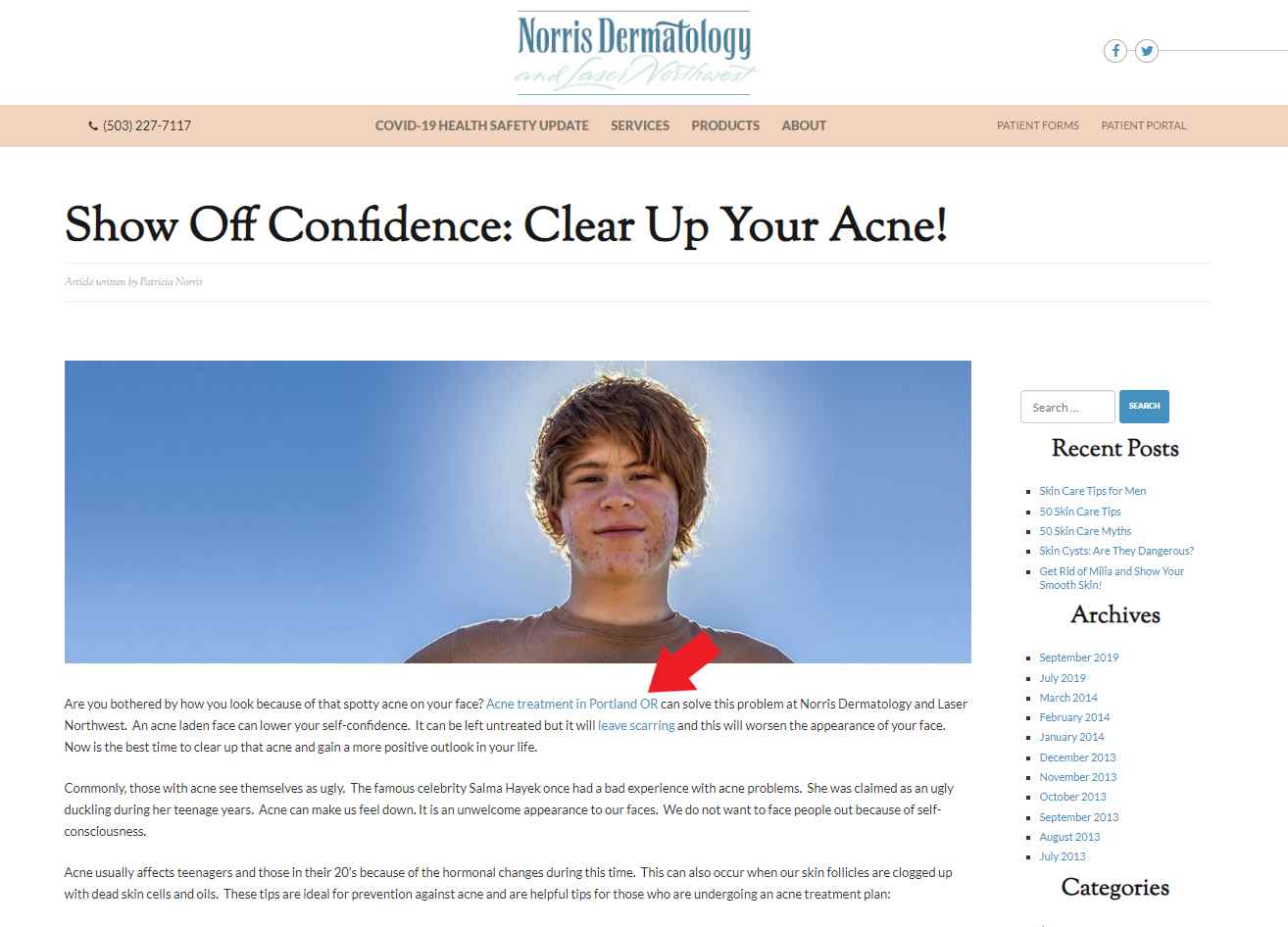Table of Contents
ToggleWhat is Content Marketing?
Content marketing is one of the cost-effective ways in attracting prospective clients to your brand. It is done by publishing relevant content which can be in the form of blog posts, podcasts, videos, infographics, and more! Based on the latest marketing report, 40% of marketers consider content marketing as a critical part of their overall marketing strategy.
So, if you’re not yet investing in this type of marketing strategy, you’re probably missing out on a lot of traffic and prospective patients to your practice!
Why Content Marketing for Dermatologists?
Whenever someone is looking for answers to their questions, the first thing that they do is search it up on a search engines like Google, Bing, or Safari. Because of that, you want to make sure that your dermatology practice shows up whenever someone asks questions that are related to skincare problems, products, and treatments. This way, your target audience will know that you are an authoritative figure in this field.
One of the main reasons why you should do content marketing is that it helps with brand awareness. Content marketing helps improve the visibility of your brand. With the use of the right keywords, hashtags (if shared on social media), and relevant content, your marketing efforts will help improve your practice’s visibility.
Next is that it helps you generate more leads. Publishing valuable content is one of the factors that make your page visitors convert. So, as long as you are tackling unique topics and appealing content for your audience, it can help you get you to generate approximately 3x more leads compared to traditional marketing.
Content marketing also helps drive additional traffic to your dermatology website. For example, one of your page visitors enjoyed watching an educational video you posted on TikTok or got hooked in reading your blogs because compared to other websites, yours have a unique approach. Because of that, that page visitor will read more of your other blog posts and might also share it with her friends whom she thinks can relate to them which brings in additional traffic to your website.
That’s how powerful content marketing is. Especially if you are able to target the topic that suits the interest of your target audience.
Lastly, well-written blog posts have the ability to drive long-term results to your dermatology practice.
Whenever someone is interested to buy something, whether it’s a product or service, they tend to do a lot of research about it. So, if you keep on publishing valuable content to your audience, your brand will stay on top of their minds whenever they are looking for something that’s relevant to dermatology. With that, they’ll start to consider you an expert in that field.
Need help generating content ideas for your dermatology practice?
Schedule A Free Strategy Session!
Content Marketing Ideas
One of the biggest challenges in content marketing is creating relevant and useful content for your audience. Worry no more, because we’ll share some ideas that will inspire you in publishing content for your dermatology practice!
1. Blog posts about common skin problems
The topics that your target audience will probably look for are solutions or ways how to prevent their skin problems. Some of the common concerns that most people encounter are acne, eczema, hives, and sunburn. As a dermatologist, you want to be a reliable source of information that your prospective patients can rely on.
This way, whenever they have concerns about their skin they’ll be reminded by your dermatology website. Here’s an example:

[Source]
If you were to read the entire article, it briefly defines how each skin type is different from the other. They also included tips on how to properly care for it. In addition to that, they stated facts in the form of bullet points which makes it easier to skim and digest the content that readers want to read first.
Blog posts like this that are short yet informative, and relevant to your practice are some of the topics that are good, to begin with.
2. Case studies
Another way to show how efficient you are as a dermatologist is by publishing case studies of your previous works. Case studies serve as proof that you’re offering high-quality services to your patients. This strategy goes beyond telling your prospective patients of how competent your dermatologists are when it comes to treating skin conditions because you’re actually showing them the background as well as the results of successful treatment sessions done on your clinic.
Here’s an example of a case study posted on a dermatology clinic’s website:


[Source]
3. Tips and advice
As a skin expert, you are knowledgeable when it comes to diagnosing and treating skin, hair, and nail problems. With that, you can establish your authority in this field by sharing tips and advice on how your patients can deal with specific skin diseases.
Here’s an example of a blog post from a dermatology practice’s website where they’ve discussed ways how to control eczema:

What’s great about this blog post is that they’ve used a sufficient number of internal and external links throughout the article. They also made sure that the entire blog was easy to read with the use of not more than three sentences per paragraph and added a relevant image on the side so that page visitors who are not that familiar with what eczema looks like, will have a better understanding of what’s causing it and the treatment options for it.
Source: https://www.cornerstonedermatology.com/
4. Content related to seasonal changes
To increase the chances of being discovered by your target audience, you can also create content that is timely. For example, during the months of June-August, you can write summer-related topics when it comes to protecting the skin from the sun.
Take a look at this example:
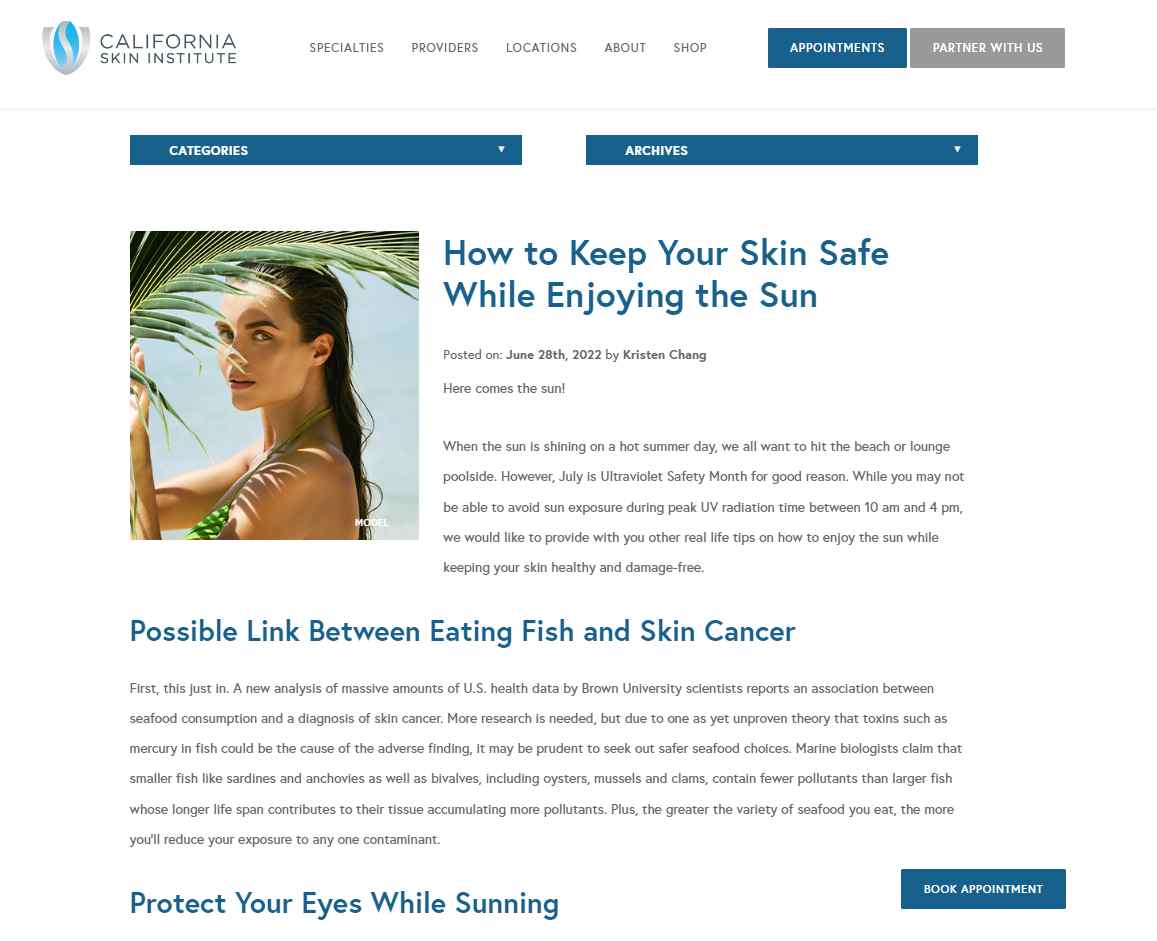
[Source]
See how they have written the title perfectly? It clearly states what the blog is all about. They also started with a brief introduction before jumping right away to what people should do to keep their skin safe under the sun.
They’ve also included relevant reports which support their claims about the correlation between eating fish and skin cancer (which can be caused by too much exposure to UV light).
Lastly, they made sure to guide their page visitors into performing an action after reading their blog. A call-to-action button that says “Book Appointment” is visible on the right side of the blog, surrounded by white space that’s visible enough for page visitors to see.
5. Skin-related infographics
Another content idea for your dermatology practice is by creating infographics that are relevant to your audience. Since 65% of the general population are visual learners, with that, you want to create content like infographics because through this format, you are able to provide useful information with the use of charts, graphs, and minimal texts.
Why use infographics in marketing your dermatology clinic?
- to make it easier for your audience to understand complex ideas
- to provide an overview of a dermatology-related topic
- to create a digestible format for your long-form article
- to educate your audience about your business
Tips for creating infographics:
- Larger elements tend to get more attention than smaller ones. So, make sure that the most important objects in your infographic are bigger than the least important ones.
- When creating infographics, see to it that the layout is properly aligned. If there’s no consistency in the way elements or texts are placed, your audience will get confused and not get the gist of your content. Take a look at the example below.
- As you can see, they want to make it easier for their readers to understand the signs of sun damage on the skin without making it look too complicated. That’s why they created labels and placed them on the opposite side of the image.
- You can also see the consistency in the font style, color, and size used. The general idea was written in a bigger font size while the subtopics were written in small fonts.
- Here’s another example. In this infographic, you can see that they emphasized the parts that seem more important, such as the areas of the face where you frequently get acne as well as the tips on how to prevent them from showing up in those areas. By using different color fonts, it’ll be easier for your readers to immediately look at the section where they relate the most.
- In this infographic, you can see how they have included everything that a person should know when it comes to wrinkles. Since they will be sharing lots of information, they made sure that they won’t lose the interest of their readers.
- What they did was use a dark background and a light-colored font so that the texts that they will be using will pop out. They also used various elements such as graphs, charts, and images to keep their audience engaged. Lastly, they made sure that their readers will not get lost while reading that’s why they’ve placed everything in the middle going downwards.
Additional for creating infographics:
- Use a snappy title
- Choose the right font style, size and colors
- Use relevant graphics
- Use an easy-to-follow layout
- Add your dermatology clinic’s logo as a watermark
- Share it on Pinterest to get additional source traffic
6. Thoughts about trending skin-care products
Nowadays, there are a lot of influencers who are sharing products that actually work well on their skin and share with their audience. However, not all of the products that they are promoting are suitable for every skin type. It would be better if people will take advice from a skin expert just to make sure that the products they’ll be using won’t cause chemical reactions or damage their skin.
With that, you can create a short video like the example below where you display skincare products that are “claimed to be effective” and share your thoughts on whether it’s dermatologically approved or not.
7. What to look for when choosing a dermatologist
There are some people who are gets nervous or hesitate when seeking help from a dermatologist. It’s because they don’t have enough knowledge on what they should do before setting an appointment, factors to consider, and the like. With that, you can write an informative blog that tells your prospective patients about the factors that they should consider before choosing a dermatologist for their skin concerns.
Here’s an example:
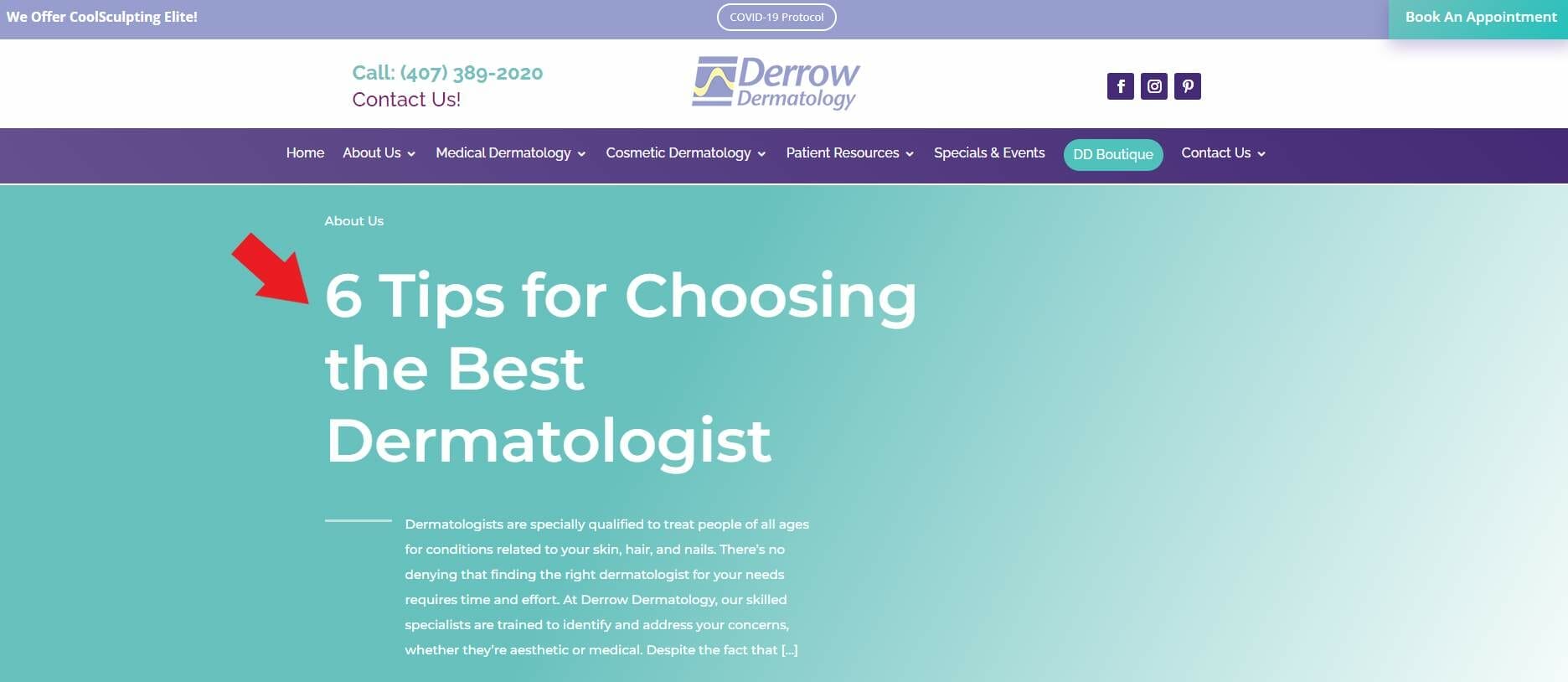
[source]
8. Home remedies for skin conditions
Another content idea that you can write about on your next blog are home remedies for specific skin conditions. Since not everyone is willing to spend a fortune on skincare products, providing natural alternatives for skin conditions that don’t require a dermatologist could be another topic you want to share with your audience. Just remember to back up your claims with research, this way people will know that your tips aside from coming from an expert, have a scientific basis and related research that proves their effectiveness.
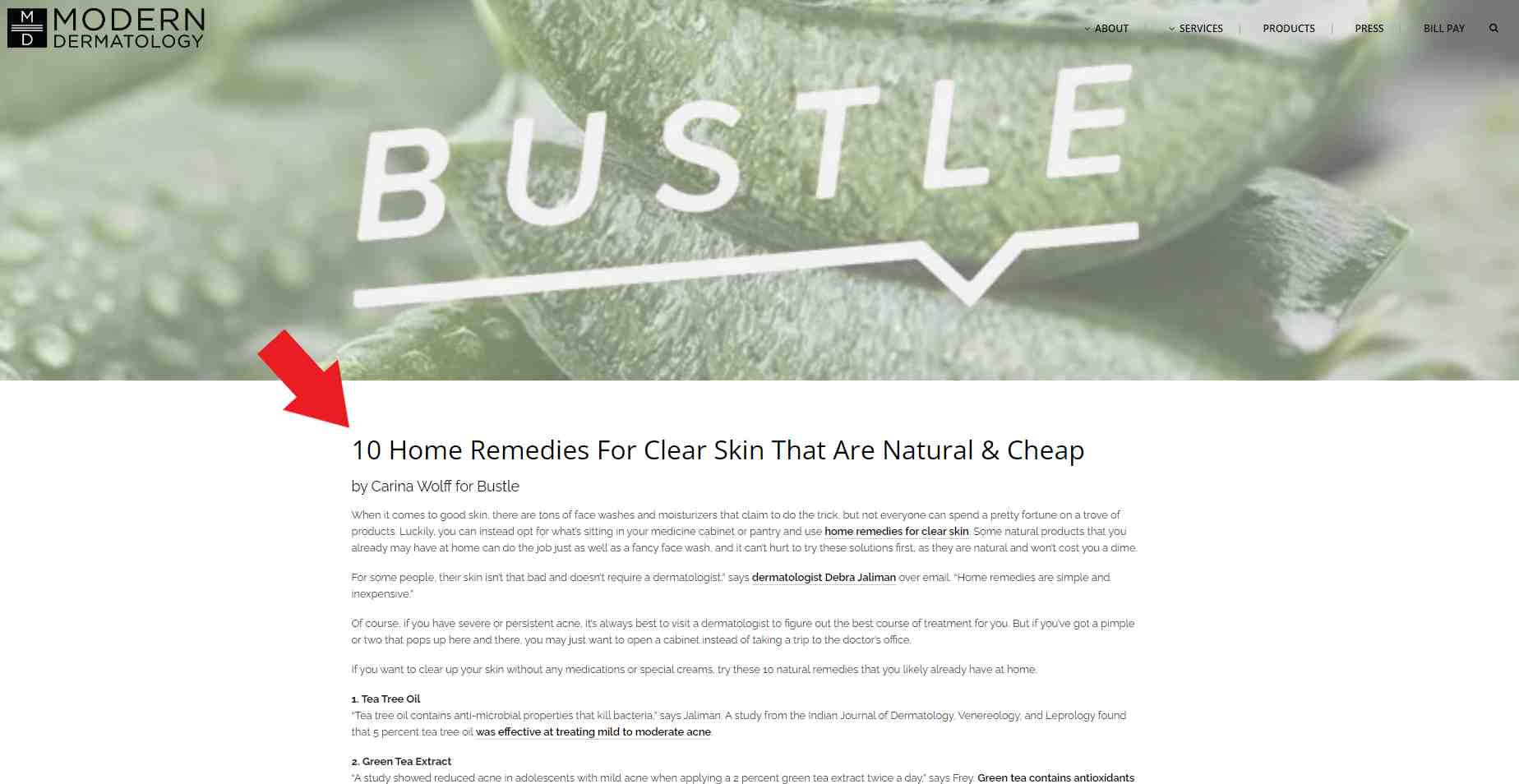
[source]
9. How cosmetic procedures work
Another content marketing idea is by sharing how dermatology procedures (e.g. facial treatments, laser rejuvenation, chemical peels, etc.). Since not everyone is familiar with how it works, or what preparations need to be made before setting an appointment for that specific procedure, writing this type of content will help grab the attention of your prospective patients who are in the consideration stage of their buying journey.
10. Debunk common skincare myths
Now that information can be easily shared through the internet, there are lots of misconceptions about caring for one’s skin. If you go through Instagram and TikTok, there are lots of posts about “skincare hacks” that have no scientific basis for how effective it is towards getting healthy and smooth skin.
As a dermatologist, you can use this as an opportunity to debunk skincare myths that circulate on social media platforms. This way, people will be aware of the viral products they should avoid before applying them to their skin.
Here’s one example of a blog post that debunks myths about skincare:
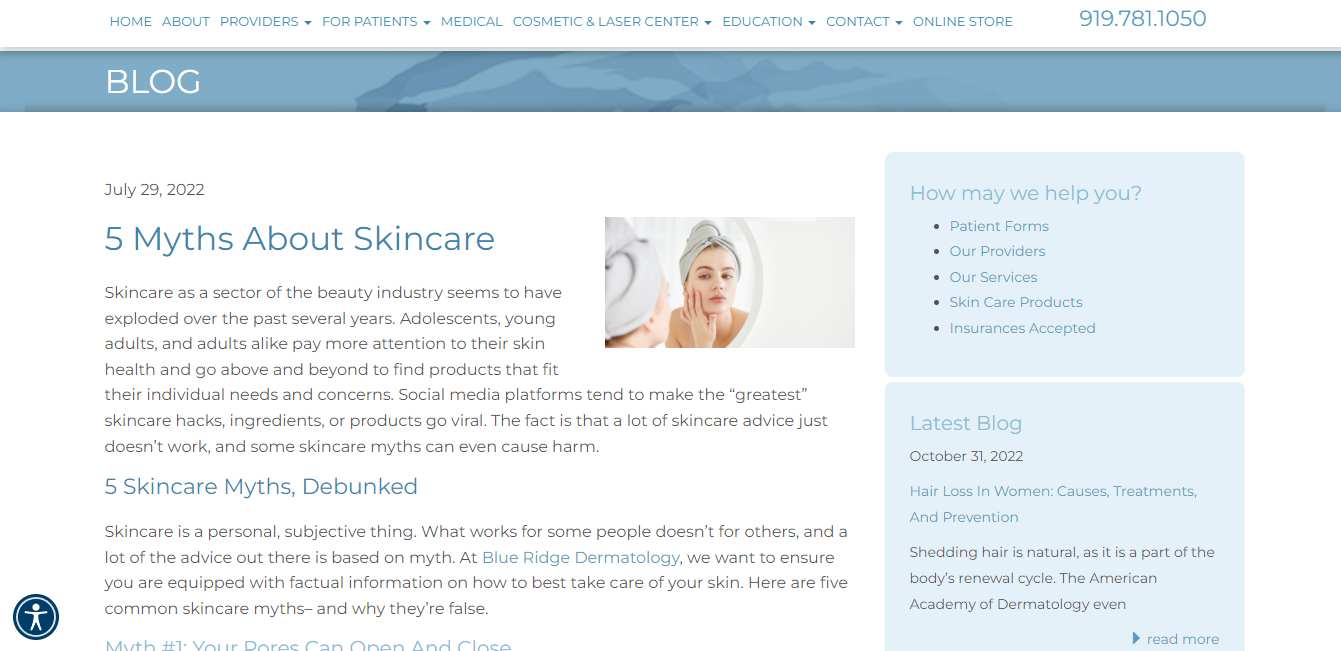
[source]
Need help writing blogs for your dermatology practice?
How to start with content marketing
Now that you have an idea of how content marketing works, we’ll walk you through the steps on how to start your content marketing strategy.
Step 1. Do keyword research
The first step in content marketing is by conducting keyword research. In this part, you’re going to investigate what search terms are commonly used by your target audience whenever they’re looking for a dermatologist or skin-related content.
Here’s how to do it:
- List down your target niche.
- You’re going to create a broad list of ideas that you want to create content out of. Some examples are common skin conditions that people encounter, hair loss, types of skin treatments, etc.
- Find relevant search terms.
- You can look for relevant search terms through Google’s autocomplete suggestions, related searches section, or a browser extension like Keyword Surfer. Aside from those mentioned, you can also get ideas on what to write about based on the titles and content of the search results of the keyword you’re going for.
- Use keyword research tools.
- Google’s Keyword Planner or SEO tools like Semrush or Ahrefs to further understand the keyword that you’re planning to use. This will give you an idea of how difficult it would be to rank for your chosen keyword, the number of average monthly searches, cost per click, etc.
- Compile your keywords in a spreadsheet.
- Once you have chosen the keywords you want to use for your content marketing strategy, compile all of those keywords in a spreadsheet where you’ll create columns based on the search volume, keyword difficulty, and cost per click. This list will become your basis when looking for keywords to use for your upcoming posts and at the same time, helps you to keep track of the topics you’ve already covered.
Step 2. Implement keywords throughout your content
Once you have your keyword list, make sure to use your target keyword throughout your content. Your chosen keyword should appear on your meta description, title tags, introduction, headings, alt-tags, and URL slug, as well as in some sections of your blog.
The meta description is a brief summary of what your content is all about. It can be seen under the title of your blog (on search results). The reason why you have to use your keywords on your meta description is that it helps search engines and your target audience become familiar of what your content is all about.
Next is title tags. These serve as the title of your webpage and should contain the main keywords of your content. This way, search engines will have a better understanding of whether your page is relevant and should show users’ search inquiries or not.
Your keywords should also be used in the headings of your blog.
When writing blog posts, make sure to use headings and incorporate keywords in them. This will make it easier for web crawlers to go through your page and identity its position on search results. Aside from search engines, headers make it easier for skimmers who want to jump right into a specific part of your blog.
Another tip is by using your main keywords in your alt-tags. Since the purpose of alt-tags is to describe the images used on your page so that in case it doesn’t load properly, adding relevant keywords in it helps improve your SEO. Just remember to not stuff your content with the same keyword, instead, use LSIs and other keyword variations so it won’t damage your SEO efforts.
Lastly, your URL slugs should also contain 1-2 of your main keywords. This will help crawl bots understand the content of your blog post.
Additional tips for URL slugs:
- use hyphens to separate words
- keep it short
- don’t use dates or years (it may look outdated)
- use lowercase
- avoid using unsafe characters
Step 3. Regularly publish content
In content marketing, you have to be consistent when publishing content.
You shouldn’t publish lots of content let’s say in a week and go inactive in the next two weeks. To help you with managing the content you’re about to post, using a content calendar can help you with that. It’ll give you an overview of the content you already published, the ones that are scheduled to be published, and also give you an idea of whether you are on the right track or not.
Sprout Social is one of the content scheduling tools that can help you follow a consistent schedule when publishing content. It allows you to save time in deciding what to post, keep track of your campaigns, visualize the content you’re going to post and collaborate with your team members!

Note: To make sure that your content gets indexed on Google, use Google Search Console. This will help you gain insights into your dermatology website’s mobile usability issues, and page experience, as well as the total number of clicks, impressions, and a lot more!
Step 4. Promote your content
Content marketing doesn’t end with publishing your blog post, video, podcast, or infographic. You have to make sure that it is available across all platforms where your target audience is. For example, after posting a blog on your dermatology clinic’s website, share it on your social media pages or post it on your Business profile.
This way, your brand will be able to reach more and more people who are interested in the products or services you’re offering.
Tips for promoting your content on other platforms:
- If promoting blog posts, get the most intriguing section from your blog and use it as a caption.
- Add a call to action to encourage your audience to take action. For example, “Check out our blog post to learn more”, or “Find out which sunscreens contain ingredients that are harmful to your skin.”
- Use a few emojis to emphasize the message you’re trying to convey.
- Use a conversational tone.
- Use hashtags to show up on relevant searches.
- When posting content on TikTok, share it also on Instagram as an IG Reel as well as on Facebook.
- Write it in a way that your audience can’t help but click on your blog post. Use emotional trigger words to ignite curiosity.
- Partner with influencers
- Influencers are individuals who already have huge follower accounts that people trust when it comes to recommending products or services that they find effective. Reaching out to influencers whom you think can help you in promoting your dermatology practice can help you get noticed by a brand new audience, build connections, and gain the trust of your potential patients.
- Here are some of the factors you should consider when finding the right influencer for your practice:
- High engagement rate
- Having a high number of followers on social media is not enough when choosing an influencer to promote your brand. You also have to look at other factors such as the engagement rate that they’re getting. Choosing an influencer with a high engagement rate is more likely to receive likes, comments, and shares which therefore helps you achieve your goal of getting lots of impressions and potential leads.
- Interested in the same niche as yours
- When choosing an influencer promoting your dermatology clinic, you have to pick the ones already interested in skincare products and treatments. It would be easier for you to reach out to these individuals because your business is relevant to their interests.
- Positive reputation
- Lastly, you also have to consider an influencer who has a good reputation. You shouldn’t just partner with an influencer based on the number of followers they have on social media. Take a look at whether they’re posting high-quality posts, receiving lots of positive comments under their posts, as well as how the majority think about him/her.
- High engagement rate
Step 5. Track the performance of your content
Once you’ve given enough time for your content to get indexed on Google, software like Google Analytics will show you charts and reports that will help you evaluate your marketing strategy. This includes the page from your website that gets the most number of views, the time of the day when your target audience visits your website, how well you retain your users, as well as the sources of where you get most of the traffic.
If you have an ongoing Google Ads campaign, you can also link it to Google Analytics. This way, you get to see your ad and website performance in just one platform!
Here’s a sample report of what you’ll see on Google Analytics:


Semrush is a reliable tool that helps you understand whether your content is performing well or not. You can also see if some of your blogs are cannibalizing (using the same keywords and ranking for other blogs from your website). Keyword cannibalizing can hurt your dermatology practice’s website which includes losing potential traffic, fluctuating search results rankings, as well as missing out on potential patients.
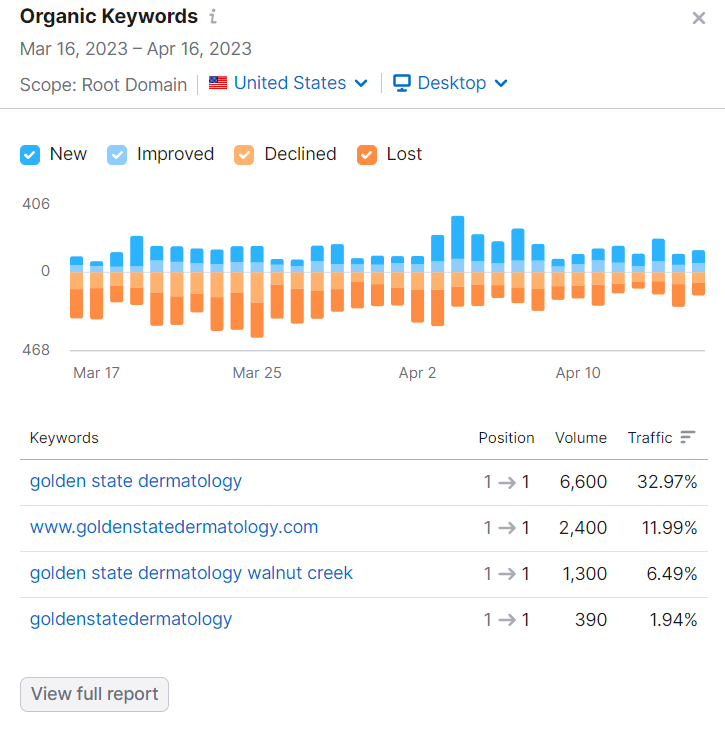
So, if you’re looking for a tool that will help you fast-track your rankings on Google, you should definitely give Semrush a try!
Step 6. Optimize your content
Let’s say your content is already showing up on search results but is not ranking that high (like on the first page of search results). You can use Page Optimizer Pro to improve the structure and content of your blog post. This will provide you with suggestions that you can do to outrank your competitors.
Here’s what suggestions look like on Page Optimizer Pro:

Don’t have time to optimize your dermatology-related content? Our team is here to help!
Key takeaway
Content marketing when done right, can result in the long-term success of your dermatology practice. As long as you’re using the right tools, and strategies and doing lots of research on the latest trends in content creation, achieving your marketing goal possible.


